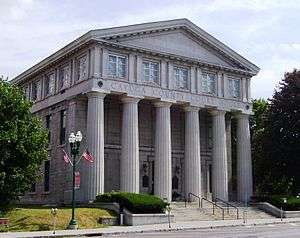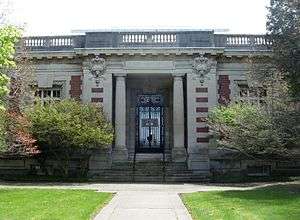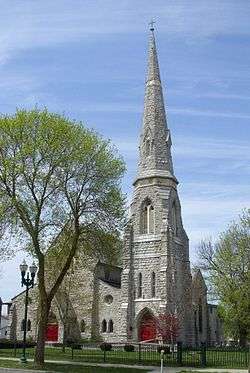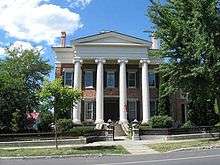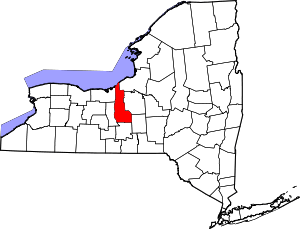Auburn, New York
| Auburn, New York | |
|---|---|
| City | |
|
Memorial City Hall (2012) | |
| Nickname(s): History's Hometown | |
 Location in Cayuga County and the state of New York. | |
| Coordinates: 42°56′N 76°34′W / 42.933°N 76.567°WCoordinates: 42°56′N 76°34′W / 42.933°N 76.567°W | |
| Country | United States |
| State | New York |
| County | Cayuga |
| Incorporated |
1815 (village) 1848 (city) |
| Government | |
| • Type | Council-Manager |
| • Mayor | Michael D Quill Sr(D) |
| • City Manager | Douglas A.Selby |
| • City Council |
Members' List
|
| Area | |
| • Total | 8.4 sq mi (21.8 km2) |
| • Land | 8.3 sq mi (21.6 km2) |
| • Water | 0.08 sq mi (0.2 km2) |
| Elevation | 686 ft (209 m) |
| Population (2010) | |
| • Total | 27,687 |
| • Density | 3,321/sq mi (1,282.3/km2) |
| Time zone | Eastern (EST) (UTC-5) |
| • Summer (DST) | EDT (UTC-4) |
| ZIP codes | 13021, 13022, 13024 |
| Area code(s) | 315 |
| FIPS code | 36-03078 |
| GNIS feature ID | 0942692 |
| Website |
www |
Auburn is a city in Cayuga County, New York, United States, located at the north end of Owasco Lake, one of the Finger Lakes, in Central New York. As of the 2010 census, the city had a population of 27,687.[1] It is the county seat of Cayuga County,[2] and the site of the maximum-security Auburn Correctional Facility, as well as the William H. Seward House Museum and the house of abolitionist Harriet Tubman.
History
.jpg)

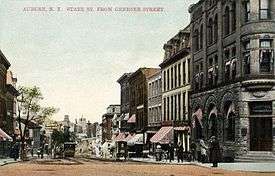
The region around Auburn had been Haudenosaunee territory for centuries before European contact and historical records.
Auburn was founded in 1793, during the post-Revolutionary period of settlement of western New York. The founder, John L. Hardenbergh, was a veteran of the Sullivan-Clinton campaign against the Iroquois during the American Revolution. Hardenbergh settled in the vicinity of the Owasco River with his infant daughter and two African-American slaves, Harry and Kate Freeman. After his death in 1806, Hardenbergh was buried in Auburn's North Street Cemetery, and was re-interred in 1852 in Fort Hill Cemetery – the first burial in the city's newly opened burial ground. The community grew up around Hardenbergh's gristmill and sawmill.[3]
Originally known as Hardenbergh's Corners in the town of Aurelius, the settlement was renamed Auburn in 1805 when it became the county seat.[4] It became an incorporated village in 1815, and was chartered as a city in 1848. It was only a few miles from the Erie Canal, which opened in 1825 and allowed local factories to inexpensively ship goods north or south. In 1871, the Southern Central Railroad, financed by the Lehigh Valley Railroad, completed a line primarily to carry coal from Athens, Pennsylvania, through Auburn to wharves on Lake Ontario at Fair Haven.[5]
From 1818 to 1939, Auburn was home to Auburn Theological Seminary, once one of the preeminent theological seminaries in the United States. In 1939, facing financial difficulties as a result of the Great Depression, the seminary moved to the campus of Union Theological Seminary in New York City. The only building from the Auburn Theological Seminary that stands today is Willard Memorial Chapel and the adjacent Welch Memorial Hall on Nelson Street, designed by Andrew Jackson Warner of Rochester, with stained-glass windows and interior decoration by Louis Comfort Tiffany. It is the only complete and unaltered Tiffany chapel interior known to exist.
In 1816, Auburn Prison (now the Auburn Correctional Facility) was founded as a model for the contemporary ideas about treating prisoners, known now as the Auburn system. Visitors were charged a fee for viewing the facility and its inmates. On August 6, 1890, the first execution by the electric chair was carried out at Auburn Prison. In 1901 Leon Czolgosz, assassin of President William McKinley, was executed there. Although the ideas of the Auburn System have been abandoned, the prison continues to serve as a maximum security facility, and is one of the most secure prisons in the continental United States.
Geography
Auburn is located at the north end of Owasco Lake, one of the Finger Lakes, which is drained by the Owasco Outlet – also known as the Owasco River – which runs north through the city on its way to the Seneca River. A dam, owned and operated by the city, controls the outflow of the lake, which is used for drinking water and recreation. The city is required to keep a sufficient amount of water in the river to deal with the effluent from its waste disposal treatment facility.[6]
According to the United States Census Bureau, the city has a total area of 8.4 square miles (21.8 km2), of which 8.3 square miles (21.6 km2) is land and 0.08 square miles (0.2 km2), or 0.89%, is water.[7]
US 20 is an important east-west highway passing through the city, and New York State Route 34 and New York State Route 38 are north-south highways that intersect US-20 in Auburn. Seneca Falls is 15 miles (24 km) west on US 20, and Syracuse is 26 miles (42 km) to the northeast via New York State Route 5.
Climate
This climatic region is typified by large seasonal temperature differences, with warm to hot (and often humid) summers and cold (sometimes severely cold) winters. According to the Köppen Climate Classification system, Auburn has a humid continental climate, abbreviated "Dfb" on climate maps.[8]
| Climate data for Auburn, New York | |||||||||||||
|---|---|---|---|---|---|---|---|---|---|---|---|---|---|
| Month | Jan | Feb | Mar | Apr | May | Jun | Jul | Aug | Sep | Oct | Nov | Dec | Year |
| Record high °F (°C) | 65 (18) |
66 (19) |
85 (29) |
92 (33) |
94 (34) |
101 (38) |
100 (38) |
99 (37) |
99 (37) |
92 (33) |
78 (26) |
64 (18) |
101 (38) |
| Average high °F (°C) | 30.0 (−1.1) |
32.1 (0.1) |
41.9 (5.5) |
54.1 (12.3) |
67.2 (19.6) |
76.1 (24.5) |
80.8 (27.1) |
78.4 (25.8) |
70.7 (21.5) |
58.9 (14.9) |
46.7 (8.2) |
35.6 (2) |
56.04 (13.37) |
| Average low °F (°C) | 12.0 (−11.1) |
12.1 (−11.1) |
21.9 (−5.6) |
33.1 (0.6) |
44.8 (7.1) |
54.6 (12.6) |
60.1 (15.6) |
58.7 (14.8) |
50.2 (10.1) |
39.1 (3.9) |
29.9 (−1.2) |
19.5 (−6.9) |
36.33 (2.4) |
| Record low °F (°C) | −23 (−31) |
−32 (−36) |
−14 (−26) |
12 (−11) |
26 (−3) |
33 (1) |
39 (4) |
39 (4) |
28 (−2) |
16 (−9) |
1 (−17) |
−21 (−29) |
−32 (−36) |
| Average precipitation inches (mm) | 2.70 (68.6) |
2.28 (57.9) |
3.03 (77) |
3.24 (82.3) |
3.61 (91.7) |
4.37 (111) |
4.17 (105.9) |
3.69 (93.7) |
4.28 (108.7) |
3.82 (97) |
3.74 (95) |
3.42 (86.9) |
42.35 (1,075.7) |
| Average snowfall inches (cm) | 34.8 (88.4) |
19.0 (48.3) |
15.3 (38.9) |
3.0 (7.6) |
.9 (2.3) |
0 (0) |
0 (0) |
0 (0) |
trace | .8 (2) |
7.9 (20.1) |
19.9 (50.5) |
101.6 (258.1) |
| Average precipitation days (≥ 0.01 in) | 18.5 | 15.9 | 13.6 | 12.1 | 13.6 | 13.9 | 11.2 | 11.0 | 13.2 | 13.6 | 13.5 | 18.2 | 168.3 |
| Average snowy days (≥ 0.1 in) | 11.5 | 8.2 | 5.5 | 1.3 | .1 | 0 | 0 | 0 | 0 | .4 | 3.4 | 8.5 | 38.9 |
| Source: NOAA (1971−2000),[9] The Weather Channel (Precipitation and Extremes)[10] | |||||||||||||
Demographics
| Historical population | |||
|---|---|---|---|
| Census | Pop. | %± | |
| 1810 | 500 | — | |
| 1820 | 2,333 | 366.6% | |
| 1830 | 4,486 | 92.3% | |
| 1840 | 5,626 | 25.4% | |
| 1850 | 9,548 | 69.7% | |
| 1860 | 10,986 | 15.1% | |
| 1870 | 17,225 | 56.8% | |
| 1880 | 21,924 | 27.3% | |
| 1890 | 25,858 | 17.9% | |
| 1900 | 30,345 | 17.4% | |
| 1910 | 34,668 | 14.2% | |
| 1920 | 36,192 | 4.4% | |
| 1930 | 36,652 | 1.3% | |
| 1940 | 35,753 | −2.5% | |
| 1950 | 36,722 | 2.7% | |
| 1960 | 35,249 | −4.0% | |
| 1970 | 34,599 | −1.8% | |
| 1980 | 32,548 | −5.9% | |
| 1990 | 31,258 | −4.0% | |
| 2000 | 28,574 | −8.6% | |
| 2010 | 27,687 | −3.1% | |
| Est. 2015 | 26,985 | [11] | −2.5% |
As of the census[13] of 2000, there were 28,574 people, 11,411 households, and 6,538 families residing in the city. The population density was 3,405.3 people per square mile (1,315.0/km²). There were 12,637 housing units at an average density of 1,506.0 per square mile (581.5/km²). The racial makeup of the city was 88.57% White, 7.59% African American, 0.29% Native American, 0.57% Asian, 0.02% Pacific Islander, 1.41% from other races, and 1.55% from two or more races. Hispanic or Latino of any race were 2.82% of the population.
There were 11,411 households out of which 28.1% had children under the age of 18 living with them, 37.3% were married couples living together, 14.7% had a female householder with no husband present, and 42.7% were non-families. 36.3% of all households were made up of individuals and 16.6% had someone living alone who was 65 years of age or older. The average household size was 2.27 and the average family size was 2.98.
In the city, the population was spread out with 22.8% under the age of 18, 9.3% from 18 to 24, 30.3% from 25 to 44, 19.8% from 45 to 64, and 17.8% who were 65 years of age or older. The median age was 37 years. For every 100 females there were 99.0 males. For every 100 females age 18 and over, there were 97.8 males.
The median income for a household in the city was $30,281, and the median income for a family was $41,169. Males had a median income of $32,349 versus $23,330 for females. The per capita income for the city was $17,083. About 12.5% of families and 16.5% of the population were below the poverty line, including 23.9% of those under age 18 and 10.2% of those age 65 or over.
Education
The Auburn Enlarged City School District is the public school system serving Auburn. It currently operates eight schools covering grades K–12. West Middle School was closed over the summer of 2011 to save funds, with the student population merged into East Middle School.
The only college in Auburn is Cayuga Community College, a two-year school. C.C.C., as it is known locally, is located on Franklin Street. The city had been the home of Auburn Theological Seminary, a Presbyterian institution established in 1818, which relocated to New York City in 1939.[14]
Sports

Professional baseball
Auburn has had a long association with professional baseball:
National Association of Professional Baseball Leagues
In late 1901, Auburn became the headquarters of the National Association of Professional Baseball Leagues (NAPBL), which is now known simply as Minor League Baseball and based in St. Petersburg, Florida. John H. Farrell, who served as secretary-treasurer of the league for many years, was a local resident, and the league's offices remained in the city while he remained in that role.
Auburn Community Baseball
Auburn Community Baseball, which is owned by the City of Auburn, is the parent organization of the Auburn Doubledays and its predecessor Auburn entries in the Class A short-season New York–Penn League dating back to 1958. The team plays its home games at Leo Pinckney Field at Falcon Park, and is an affiliate of the Washington Nationals.
The Great Race
Since 1978, on the second Sunday of every August, Auburn hosts "The Great Race", a three- or four-person relay race involving running, cycling, and canoeing (or kayaking). The race begins and ends in the area of Owasco Lake on the southern outskirts of Auburn. With between 2,000 and 2,500 people participating in an average year, it is one of the largest relay races in the United States.[15]
Media
The daily newspaper published in Auburn is The Citizen, which dates back to 1816, and had previously been published as The Daily Advertiser and The Citizen-Advertiser. It serves Auburn and Cayuga County, as well as other parts of Central New York. A morning paper, published seven days a week, it has a circulation of 10,000 for the daily and Saturday editions, and 12,000 on Sunday. It is owned by Lee Enterprises.
Notable people



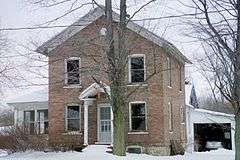
Possibly the two best-known historical figures associated with Auburn are William H. Seward and Harriet Tubman.
Seward – who served as a New York state senator, the governor of New York, a U.S. senator, a presidential candidate, and then Secretary of State under presidents Abraham Lincoln and Andrew Johnson, in which role he negotiated the 1867 purchase from Russia of Alaska, which became known as "Seward's Folly" – lived in Auburn from 1823 until his death in 1872, and was opposed to slavery. Seward's wife, Frances Adeline Seward was deeply committed to the abolitionist movement, which was strongly supported in Auburn. In the 1850s, the Seward family opened their Auburn home as a safehouse to fugitive slaves on the Underground Railroad. In 1859 Seward sold a plot of land to abolitionist Tubman, who used it to create a safe haven for her family and friends and other black Americans seeking a better life in the north.[16] Seward's house is now a historical museum, and both it and Tubman's house are on the National Register of Historic Places.
Business and inventors
- Willard Bundy, invented first time clock
- Theodore Case, developed the first commercially successful system of recording sound on film
- Jerome H. Holland, first African-American board member of the American Stock Exchange
- Birdsill Holly, supposed inventor of the fire hydrant
- Phil Romano, restaurateur, founder of Fuddruckers and Romano's Macaroni Grill
Government, politics, and law
- Harry Elmer Barnes, historian, scholar and social scientist
- John Beardsley (1783–1857), judge, assemblyman, state senator and warden of Auburn state prison
- Samuel Blatchford, Associate Justice of the United States Supreme Court
- William H. Carpenter, U.S. Consul to Foochow, China 1861-1865
- William Miller Collier, diplomat, attorney, president of George Washington University, author of Collier on Bankruptcy
- Alfred Conkling Coxe, Sr., federal judge
- Amy Dacey, Democratic National Committee, CEO
- Ulysses F. Doubleday, congressman, father of Abner Doubleday
- Eleanor Lansing Dulles, diplomat
- Nathaniel B. Eldredge, congressman
- William (Bill) Fulton, author, urban planner, and mayor of Ventura, California
- Milo Goodrich, congressman
- Jerome Holland, first African American ambassador to a European nation (Sweden, 1972); president of Hampton University
- Thomas Y. Howe, Jr., mayor and congressman[17]
- James Lockhart, congressman from Indiana[17]
- Virginia V. Lyons, politician
- Clinton D. MacDougall, congressman
- Truman A. Merriman, congressman[17]
- Thomas Mott Osborne, prison reformer
- Sereno E. Payne, first House Majority Leader
- Theodore Pomeroy, speaker of the house and mayor
- Frederick W. Seward, assistant secretary of state
- William G. Stahlnecker, congressman
- John Taber, congressman
- Enos T. Throop, 10th Governor of New York
- Floyd K. Whittlemore, Illinois state treasurer
- Martha Coffin Wright, feminist and participant in the Seneca Falls convention
Military
- Abner Doubleday, general and for many years credited as creator of baseball
- William H. Seward, Jr., brevet brigadier general
- William J. Sharkey, naval officer
- Robert F. Stryker, Vietnam War Medal of Honor recipient
Sports, arts, and entertainment
- Eric Adams (real name Louis Marullo), Manowar singer
- Pete Mendillo (musician), [Survivor, Savoy Brown, Brian Howe(Bad Company), Brad Whitford (Aerosmith]] Drummer
- Samuel Hopkins Adams, author
- Kelly Brannigan, model (Deal or No Deal)
- John Chester Buttre, artist and publisher of The American Portrait Gallery[17]
- Scott Columbus, Manowar drummer
- Earl Conrad (birth name Eli Cohen), journalist, author
- Richard and John Contiguglia, twin pianists
- Joey DeMaio, Manowar bassist
- Greg Downing, lacrosse player
- Charles Loring Elliott, portrait painter
- Joey Foster Ellis, artist
- Buddy Hardeman, football running back
- Raymond Hitchcock, actor
- Mark Jindrak, ex-WWE wrestler
- Joe Kehoskie, baseball agent
- John, Mike, and Tom Mansell, major league baseball players
- Marijane Meaker, award-winning author of young adult fiction (as "M.E. Kerr")
- T. J. Middleton, tennis player
- Jeremy Morin, NHL player
- Bob Mosher, TV and film writer
- Jerry O'Neil, NASCAR driver
- Jane Peyton, actress wife of Samuel Hopkins Adams
- Kevin Polcovich, Major League Baseball player
- Julius Schweinfurth, architect
- Stanley Shakespeare, NFL player
- Sir James Jebusa Shannon, artist
- Alexander Theobald Van Laer, painter
- John Walsh, host of America's Most Wanted and The Hunt with John Walsh
- Thommie Walsh, dancer, choreographer and director
Other
- Avery Robert Dulles, cardinal and theologian
- William Kemmler, Auburn Prison inmate, first person executed by electric chair
- Michael Lynch, geneticist
- A. T. Mann, astrologer, architect and graphic artist
- Frederick Starr, professor and anthropologist
- Annie Edson Taylor, the first person to survive a trip over Niagara Falls in a barrel
Places of historic interest
A number of properties in Auburn are listed on the National Register of Historic Places, including the Auburn Button Works and Logan Silk Mills, the Belt-Gaskin House, Case Memorial-Seymour Library, the Cayuga County Courthouse and Clerk's Office, the Harriet Tubman Home for the Aged, William and Mary Hosmer House, St. Peter's Episcopal Church Complex, Sand Beach Church, Schines Auburn Theatre, Thompson AME Zion Church, Harriet Tubman Grave, Harriet Tubman House, the Old Post Office and Courthouse, Wall Street Methodist Episcopal Church, and Dr. Sylvester Willard Mansion. The William H. Seward House and Willard Memorial Chapel-Welch Memorial Hall are National Historic Landmarks, and the South Street Area Historic District is a national historic district.[18]
See also
 New York portal
New York portal
References
Notes
- ↑ "Profile of General Population and Housing Characteristics: 2010 Demographic Profile Data (DP-1): Auburn city, New York". U.S. Census Bureau, American Factfinder. Archived from the original on September 11, 2013. Retrieved March 15, 2012.
- ↑ "Find a County". National Association of Counties. Archived from the original on May 31, 2011. Retrieved 2011-06-07.
- ↑ Historical & Cultural Auburn, New York
- ↑ The name Auburn resonated with the opening lines of Oliver Goldsmith's then-familiar poem "The Deserted Village" (1770): "Sweet Auburn, loveliest village of the plain, Where health and plenty cheered the labouring swain."
- ↑ Lehigh Valley Railroad Historical Society
- ↑ "Oasco Lake, Central New York" on FindLakes.com
- ↑ "Geographic Identifiers: 2010 Demographic Profile Data (G001): Auburn city, New York". U.S. Census Bureau, American Factfinder. Retrieved November 12, 2014.
- ↑ Climate Summary for Auburn, New York
- ↑ "Climatology of the United States No. 20: AUBURN, NY 1971–2000" (PDF). National Oceanic and Atmospheric Administration. Retrieved November 2011. Check date values in:
|access-date=(help) - ↑ "Monthly Averages for Auburn, NY (13021)". The Weather Channel. Retrieved November 2011. Check date values in:
|access-date=(help) - ↑ "Annual Estimates of the Resident Population for Incorporated Places: April 1, 2010 to July 1, 2015". Retrieved July 2, 2016.
- ↑ "Census of Population and Housing". Census.gov. Archived from the original on May 11, 2015. Retrieved June 4, 2015.
- ↑ "American FactFinder". United States Census Bureau. Archived from the original on September 11, 2013. Retrieved 2008-01-31.
- ↑ "Our History" Auburn Theological Seminary website
- ↑ The Great Race website
- ↑ Larson, Kate Clifford (2004). Bound for the Promised Land: Harriet Tubman, Portrait of an American Hero. New York: Ballantine Books. ISBN 0-345-45627-0. p.16
- 1 2 3 4 Who Was Who in America, Historical Volume, 1607-1896. Chicago: Marquis Who's Who. 1963.
- ↑ National Park Service (2009-03-13). "National Register Information System". National Register of Historic Places. National Park Service.
External links
| Wikimedia Commons has media related to Auburn, New York. |
| Wikivoyage has a travel guide for Auburn, New York. |
- City of Auburn official website
- Cayuga Economic Development Agency
- Cayuga County Chamber of Commerce
- Seymour Library
- Willard Memorial Chapel
- Cayuga Museum of History & Art and The Case Research Lab Museum
- Auburn Players Community Theatre, Inc.
- Finger Lakes Musical Theatre Festival
- Auburn Public Theater
- Cayuga County Arts Council Network
- Auburn Musical Theatre Festival
- Schweinfurth Memorial Art Center
- Ward W. O'Hara Agricultural Museum
- Auburn History, Old Newspaper Articles, Genealogy
- Cayuga Community College


